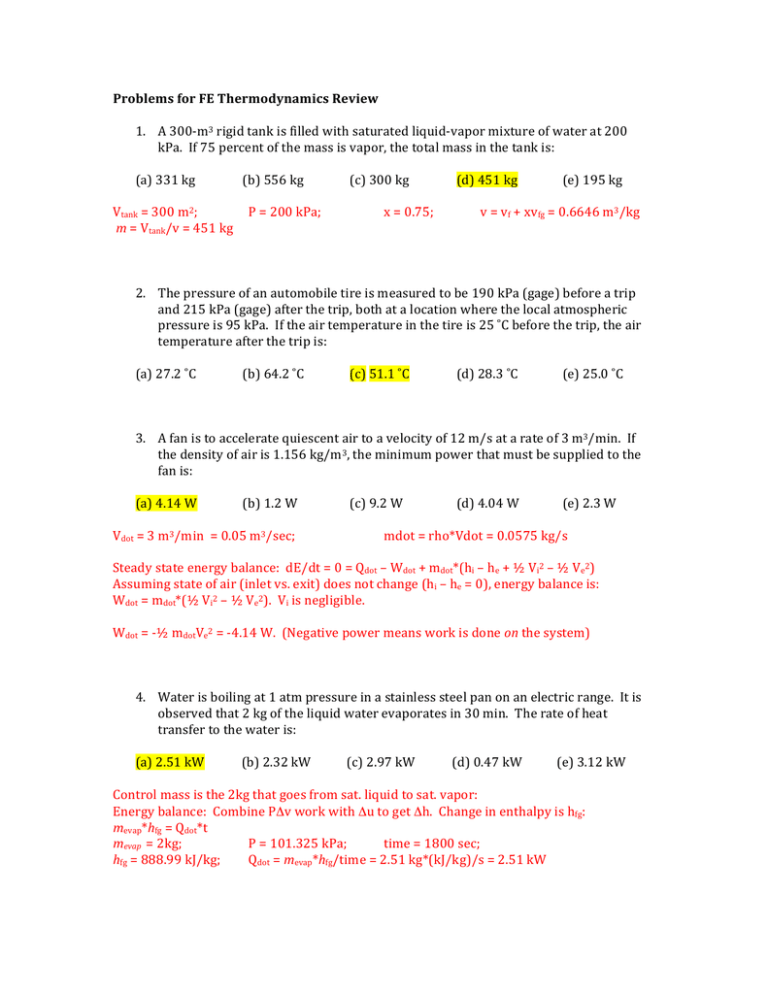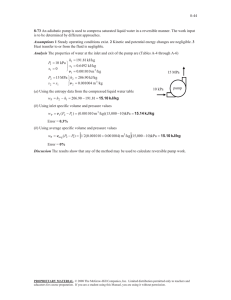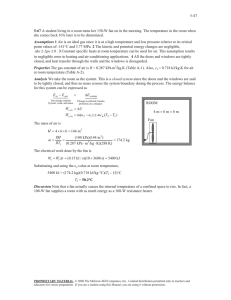Problems For FE Thermodynamics Review SOLUTIONS
advertisement

Problems for FE Thermodynamics Review 1. A 300-­‐m3 rigid tank is filled with saturated liquid-­‐vapor mixture of water at 200 kPa. If 75 percent of the mass is vapor, the total mass in the tank is: (a) 331 kg (b) 556 kg (c) 300 kg (d) 451 kg (e) 195 kg 2 Vtank = 300 m ; P = 200 kPa; x = 0.75; v = vf + xvfg = 0.6646 m3/kg m = Vtank/v = 451 kg 2. The pressure of an automobile tire is measured to be 190 kPa (gage) before a trip and 215 kPa (gage) after the trip, both at a location where the local atmospheric pressure is 95 kPa. If the air temperature in the tire is 25 ˚C before the trip, the air temperature after the trip is: (a) 27.2 ˚C (b) 64.2 ˚C (c) 51.1 ˚C (d) 28.3 ˚C (e) 25.0 ˚C 3. A fan is to accelerate quiescent air to a velocity of 12 m/s at a rate of 3 m3/min. If the density of air is 1.156 kg/m3, the minimum power that must be supplied to the fan is: (a) 4.14 W (b) 1.2 W (c) 9.2 W (d) 4.04 W (e) 2.3 W Vdot = 3 m3/min = 0.05 m3/sec; mdot = rho*Vdot = 0.0575 kg/s Steady state energy balance: dE/dt = 0 = Qdot – Wdot + mdot*(hi – he + ½ Vi2 – ½ Ve2) Assuming state of air (inlet vs. exit) does not change (hi – he = 0), energy balance is: Wdot = mdot*(½ Vi2 – ½ Ve2). Vi is negligible. Wdot = -­‐½ mdotVe2 = -­‐4.14 W. (Negative power means work is done on the system) 4. Water is boiling at 1 atm pressure in a stainless steel pan on an electric range. It is observed that 2 kg of the liquid water evaporates in 30 min. The rate of heat transfer to the water is: (a) 2.51 kW (b) 2.32 kW (c) 2.97 kW (d) 0.47 kW (e) 3.12 kW Control mass is the 2kg that goes from sat. liquid to sat. vapor: Energy balance: Combine PΔv work with Δu to get Δh. Change in enthalpy is hfg: mevap*hfg = Qdot*t mevap = 2kg; P = 101.325 kPa; time = 1800 sec; hfg = 888.99 kJ/kg; Qdot = mevap*hfg/time = 2.51 kg*(kJ/kg)/s = 2.51 kW 5. A 0.5-­‐m3 cylinder contains nitrogen gas at 600 kPa and 300 K. Now the gas is compressed isothermally to a volume of 0.1 m3. The work done on the gas during this compression process is: (a) 720 kJ (b) 483 kJ (c) 240 kJ (d) 175 kJ (e) 143 kJ 6. A well-­‐sealed room contains 60 kg of air at 200 kPa and 25 ˚C. Now solar energy enters the room at an average rate of 0.8 kJ/s while a 120-­‐W fan is turned on to circulate air in the room. If heat transfer through the walls I negligible, the air temperature in the room in 30 min. will be: (a) 25.6 ˚C (b) 49.8 ˚C (c) 53.4 ˚C (d) 52.5 ˚C (e) 63.4 ˚C Energy balance: dU/dt = Qdot,solar -­‐ Wdot,fan. à ΔU = mCvΔT = (Qdot,solar -­‐ Wdot,fan)*Δt Qdot,solar = 0.8 kJ/s; Wdot,fan = -­‐0.120 kJ/s; Cv = 0.717 kJ/kg-­‐K ; Δt = 1800 s T2 = T1 + (Qdot,solar -­‐ Wdot,fan)*Δt/m/Cv = 25 ˚C +(0.8 + 0.120 kJ/s)*1800s/60 kg/0.717 kJ/kg-­‐K = 63.4 C 7. A 2-­‐kW electric resistance heater submerged in 5-­‐kg water is turned on and kept on for 10 min. During the process, 300 kJ heat is lostr from the water. The temperature rise of the water is: (a) 0.4 ˚C (b) 43.1 ˚C (c) 57.4 ˚C (d) 71.8 ˚C (e) 180 ˚C ΔU = Qloss -­‐ Wheater = – 300 kJ – Wdot,heater*Δt = –300 kJ – (-­‐2kW*600s ) = 900 kJ ΔU = mC ΔT = 5kg *4.18 kJ/kg-­‐K * ΔT ΔT = 900 kJ/5 kg/4.18 kJ/kg-­‐K = 43.1 ˚C 8. In a heating system, cold outdoor air at 7˚C flowing at a rate of 4 kg/min is mixed adiabatically with heated air at 70˚C flowing at a rate of 3 kg/min. The exit temperature of the mixture is: (a) 34 ˚C (b) 39 ˚C (c) 45 ˚C (d) 63 ˚C (e) 77 ˚C 9. Steam is compressed by an adiabatic compressor from 0.2 MPa and 150˚C to 0.8 MPa and 350 ˚C at a rate of 1.30 kg/s. The power input to the compressor is: (a) 511 kW (b) 393 kW (c) 302 kW (d) 717 kW (e) 901 kW Steady state energy balance for control volume: dE/dt = 0 = Qdot – Wdot + mdot(hi – he) adiabatic: Qdot = 0; Wdot = mdot(hi – he) = 1.30 kg/s*(hi – he) hi = 2769 kJ/kg; he = 3162.2 Wdot = -­‐511 kW 10. Refrigerant R-­‐134a at 1.4 MPa and 90 ˚C is throttled to a pressure of 0.6 MPa. The temperature of the refrigerant after throttling is: (a) 22˚C (b) 56 ˚C (c) 82˚C (d) 80˚C (e) 90˚C 11. Steam is condensed at a constant temperature of 30˚C as it flows through the condenser of a power plant by rejecting heat at a rate of 55 MW. The rate of entropy change of steam as it flows through the condenser is: (a) -­‐1.83 MW/K (b) -­‐0.18 MW/K (c) 0 MW/K (d) 0.56 MW/K (e) 1.22 MW/K dS/dt = Q/T + mdot*(si – se) + Sgen; Steady state: dS/dt = 0 If heat transfer takes place at 30˚C, it is internally reversible: Sgen = 0 Rate of entropy change is mdot*(se – si) = -­‐55 MW/303.15 K = -­‐0.181 MW/K 12. Helium gas is compressed from 1 atm and 25 ˚C to a pressure of 10 atm adiabatically. The lowest temperature of helium after compression is : (a) 25 ˚C (b) 63 ˚C (c) 250 ˚C (d) 384 ˚C (e) 476 ˚C 13. Liquid water enters an adiabatic piping system at 15˚C at a rate of 8 kg/s. If the water temperature rises by 0.2˚C during flow due to friction, the rate of entropy generation in the pipe is: (a) 23 W/K (b) 55 W/K (c) 68 W/K (d) 220 W/K (e) 443 W/K 14. Air in an ideal Diesel cycle is compressed from 2 to 0.13 L, and then it expands during the constant pressure heat addition process to 0.30 L. Under cold air standard conditions, the thermal efficiency of this cycle is: (a) 41% (b) 59% (c) 66% (d) 70% (e) 78% V1 = 2 L; V2 = 0.13 L; V3 = 0.30 L; r = V1/V2 = 15.385; rc = V3/V2 = 2.308; k = 1.4 ηDiesel = 1-­‐r(1-­‐k)[(rck – 1)/(k*(rc – 1))] = 0.59 15. An ideal Brayton cycle has a net work output of 150 kJ/kg and a back-­‐work ratio of 0.4. If both the turbine and the compressor had an isentropic efficiency of 85 percent, the net work output of the cycle would be: (a) 74 kJ/kg (b) 95 kJ/kg (c) 109 kJ/kg (d) 128 kJ/kg (e) 177 kJ/kg Wcomp/Wturb = 0.4 Wnet,ideal = Wturb – Wcomp = 150 kJ/kg 2 equations, 2 unkonwns: à Wturb = 250 kJ/kg, Wcomp = 100 kJ/kg η = 0.85 Wnet_actual = ηWturb – Wcomp/η = 95 kJ/kg 16. A simple ideal Rankine cycle operates between the pressure limits of 10 kPa and 5 MPa, with a turbine inlet temperature of 600 ˚C. The mass fraction of steam that condenses at the turbine exit is: (a) 6% (b) 9% (c) 12% (d) 15% (e) 18 % Turbine inlet: P = 5 MPa, T = 600 C à s = 7.2605 kJ/kg-­‐K Turbine exit: P = 10 kPa. For ideal, sout= sin. x = (s – sf)/sfg = 0.88 Condensed fraction = 1 -­‐ x = 0.12 17. Consider a refrigerator that operates on the vapor compression refrigeration cycle with R-­‐134a as the working fluid. The refrigerant enters the compressor as saturated vapor at 160 kPa, and exits at 800 kPa and 50˚C, and leaves the condenser as saturated liquid at 800 kPa. The coefficient of performance of the refrigerator is: (a) 2.6 (b) 1.0 (c) 4.2 (d) 3.2 (e) 4.4




